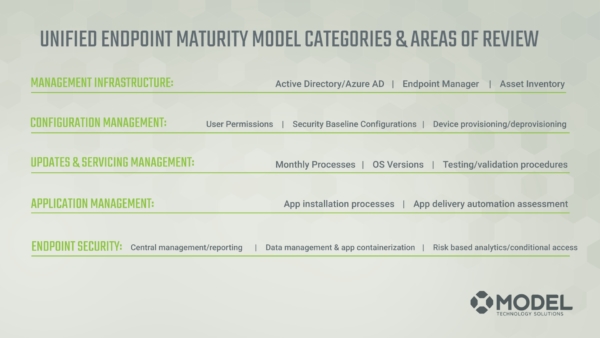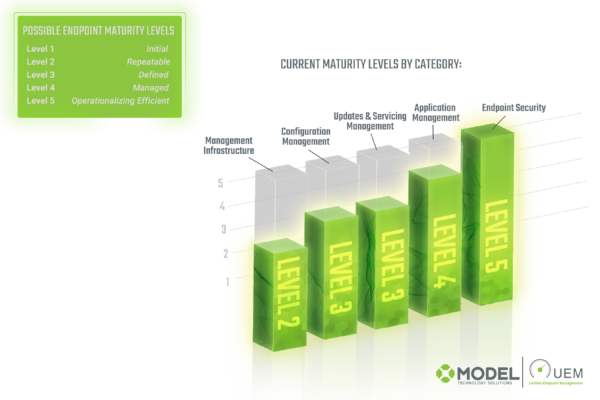Welcome to the second article in our series on Unified Endpoint Management: Laying The Foundation For UEM: Management Infrastructure Maturity Level 1.
If you haven’t read the first post, you can read it here. It’s a core foundational post in this series, and I’d encourage you to read it before you read this post. In it you’ll get an overview of our maturity model that’s more in depth than what we’re going to go through today.
In today’s post, I’ll:
- Give a brief overview of Unified Endpoint Management
- Talk a little bit about the maturity model phases and categories
- Explore the first level of the Management Infrastructure category
What is Unified Endpoint Management?
Traditionally the term UEM would mean simply a single platform for management of devices. At Model, though, we use a more nuanced definition.
Standard Definition: A single platform for management of devices such as phones, tablets, laptops, and desktops supporting many different use cases.
Model’s Definition: A collection of processes supported by technology for the management of devices such as phones, tablets, laptops, and desktops supporting many different use cases coupled with well-defined processes, molded to your organization’s security and application needs, to enable productivity while reducing potential security risks.
In our perspective on UEM, we always take into consideration:
- An organization’s security needs
- Their application needs
- Ways to enable productivity
- Opportunities to reduce potential risks
From this view, we’ve created our own UEM maturity model. In our model, we apply processes specifically to 5 different infrastructure categories.
- Management Infrastructure
- Configuration Management
- Updates and Servicing
- Application Management
- Endpoint security

We then use give infrastructures a rating from 1-5 in each of those categories according to the phase that they’re in.

Our maturity model phases are not necessarily unique. But the different categories we assign the phases to are completely unique to our maturity model.
And today we’re going to be covering the initial phase of Management Infrastructure, e.g. Level 1. We’ll cover what that looks like, the benefits of implementing it, and the elements you need in order to implement.
The Features of a Level 1 Management Infrastructure
One of the features in Level 1 Management Infrastructure is:
- An central view of all your devices.
Active Directory is one example. With Active Directory, you can look at a view of all your devices simultaneously.
Several other benefits are:
- A basic asset inventory
- Initial configuration capabilities (e.g. group policy objects, scripts, or startup scripts)
A Level 1 Management Infrastructure is also a foundation to facilitate many other aspects of strategic growth. Whether it’s in terms of size, technology, or collaboration, Level 1 Management Infrastructure is almost always a requirement. Like the foundation of a house, everything you build moving forward is often built on top of it.
The “Initial” phase of any of our UEM categories may seem rather basic. But when it comes to some of the feature sets, configurations, and paths farther down the maturity model, Level 1 is incredibly important to think about.
As I said before, think of this whole maturity model like a house. Your basement is a part of the foundation of your house, but you rarely think about it in terms of stability – but it is! You want your basement for your house built structurally sound without leaking water. Similarly, you always want to choose the right toolset and features as a foundation for future UEM building, and you also want to implement these tools in the right way.
Ultimately, you want your Management Infrastructure to be able to do everything that you want with as little administrative effort as possible.
And that’s why you should think through the initial phase if you’re wanting to implement any level of UEM moving forward.
Potential Impacts of a Level 1 Management Infrastructure
Just by having a Level 1 Management Infrastructure in place, you will have already enabled many impacts and benefits, including:
- Improved security posture
- Control over user/computer settings/features
- Reduced administrative effort
- Improved collaboration
How Do You Implement a Level 1 Management Infrastructure
First you need to define your need. You’ve got a handful of users and devices and, for example, maybe:
- You’ve determined that you don’t know if any virus is currently in your system
- You don’t know if you’re getting patches on these PCs efficiently
- You’d like to distribute a printer driver
- You’d like to automate software distribution
Now you need to identify a Possible Future State. As a part of this, you should conceptualize:
- What projects you need to do now
- What projects you could do a couple years from now
Both these should be considered in your one-to-three-year Management Infrastructure plan.
After identifying your plan, you need to identify:
- Your timeline for when you need functionality to be operational
- The anticipated costs and how that aligns against the budget that you have allocated for a Management Infrastructure
- The appropriate technology or platform that is required that would meet your need or your future state
Examples of Level 1 Management Infrastructure Technology
- Active Directory
Having a central directory of your users and devices.
- Azure Active Directory
Azure AD is Microsoft’s cloud-based directory service that can enable many benefits, including collaboration.
- Intune (Endpoint Manager)
Maybe you’re at the stage in your organization that you need a little more than Azure AD can provide in terms of Management infrastructure. If so, Intune or MEM would be appropriate tools to use.
- MECM (SCCM/Microsoft Endpoint Configuration Manager)
Ultimately the technology or platform you choose should fit in with your timeline and your budget. The cost to purchase would be less than what you would save using the appropriate technology platform.
Once you have all these items in place, you can move into implementing a Level 1 Management Infrastructure.
The Model Maturity Assessment
Now, if you’re thinking, how do I do all of that? That seems like a lot of work! Well, we can help.
Through two 90 minute sessions and a brief list of questions you answer on your own, we’ll create a findings and recommendations report for your organization which will be your done-for-you first step down the maturity model. The questions are technology- and process-based, and they will help you to identify:
- Where you currently are
- Where you want to be down the road (e.g. your Possible Future State)
This assessment normally costs $3,000, but as a part of our UEM Series we’re offering it for free for qualified customers. Just reach out to see if you qualify to receive this assessment free of charge.
This concludes Management Level 1! Please feel free to reach out if you have any questions or concerns!
